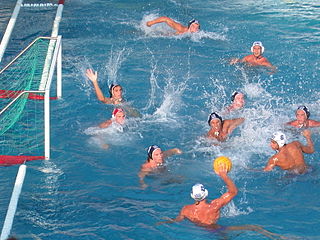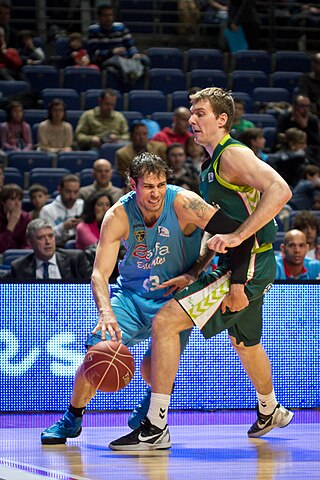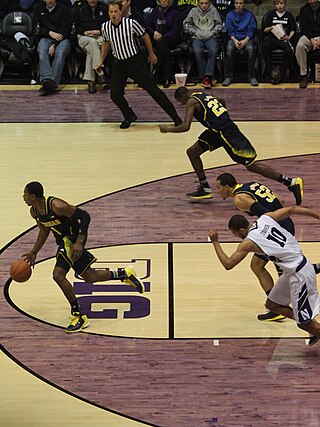This article includes a list of general references, but it lacks sufficient corresponding inline citations .(July 2010) |
The amoeba defense is a defensive strategy in the game of basketball.
This article includes a list of general references, but it lacks sufficient corresponding inline citations .(July 2010) |
The amoeba defense is a defensive strategy in the game of basketball.
The amoeba defense was developed by Fran Webster, an assistant for the Pittsburgh Panthers men's basketball team. [1] In the 1970s, Webster perfected the defense with Pittsburgh head coaches Charles Ridl and Tim Grgurich. Grgurich later became an assistant to UNLV coach Jerry Tarkanian, who utilized the defense himself. Pitt used the defense extensively in their 1974 season run to the Elite 8, winning 22 straight games in the process, before losing to eventual National Champion, North Carolina State in the East Region Finals (Elite 8). [2]
The amoeba defense is a basketball defense used to wear down an offense. It is a risky defense that mixes the man-to-man and zone defenses together. The defense is set up like a diamond. The two quickest players, usually the point and shooting guards, should be set at the top of the key and just above the free throw line, while your biggest defender, most commonly the center or power forward, is set up under the basket and your other two defenders are set up on opposite sides of the lane just below the elbows.
The defender at the top of the key picks up the dribbler advancing up the court. The defender at the free throw line then sprints out and picks up the entry pass. The top defender then drops back to the free throw line where the defender now guarding the ball previously had been. If the ball handler begins to dribble the defender just below the elbow on the same side as the ball would then double team the ball handler with the defender already defending the ball. The defender below the opposite elbow then drops under the basket while the defender that was previously under the basket fronts the offensive player on the post. The defender originally at the top of the key is now at the free throw line anticipating the next pass in hopes of intercepting the pass and starting a fast break.
When the ball is passed into the corner the defender who started under the basket should sprint out to the ball. The defender originally playing below the elbow then drops to front the offensive post player. The defender originally at the free throw line is now on the wing denying the pass back up to the wing. The defender originally occupying the space below the elbow on the opposite side of the ball has now dropped under the basket and has backside responsibility while the defender originally at the top of the key sits at the free throw line and has top side responsibility.
In the event of a skip pass the defender with backside responsibility would sprint out to guard the ball. The defender guarding the ball then shifts back under the basket where they started. The defender who had been fronting the post then sprints over to the position just under the elbow on the opposite side. The defender at the free throw line then sprints out to deny the pass back to the top while the defender that had previously been denying the pass to the wing shifts back to the free throw line where they originally started.
A two-guard front is a different offensive formation in which two players begin at the top of the key, one player plays the high post and the other two players are positioned just above the baseline outside the three-point line. When defending against a two guard front in the amoeba defense the formation changes from a diamond shape to a 2-1-2 defense. The top two defenders who we first stacked at the free throw line and top of the key come up to defend the two guards. The defender under the basket then comes up to the free throw line and guards behind the high post. While the defenders on either side of the lane stay put to guard the pass to the corner. Ideally the ball handler would pass the ball to the high post. In that situation both defenders up top both drop down to the free throw line to triple team the high post. The high post would, in the perfect situation, panic and make a bad pass. The two defenders down low should then anticipate the pass and intercept it.
In the event that the triple team fails and the high post is able to make a pass to the wing the defender closest to the ball must sprint out to defend it. The defender that started guarding the high post then retreats to the post while the defender playing on the side of the lane closest to the ball sprints out and defends the pass to the corner. The last defender left that was previously triple teaming stays at the free throw line to deny the post and the defender playing on the opposite side of the lane drops under the basket. The defender now denying the pass to the high post now has to deny passes to the high post, wing and cross court. It is critical that the players denying passes to the high post and wing in this situation are your quickest players.
The amoeba defense is a gambling defense; if used correctly it can lead to many fast breaks and easy layups, although if beaten the defense almost always leads to an uncontested layup or open shot. When used in cooperation with the man-to-man defense it can disrupt any offense and lead to many scoring streaks. Since the defense was developed, many high school and college teams such as Mississippi have been very successful when using the defense in combination with other defenses. The defense is seen more in younger play because professional athletes are much faster and much better shooters. The amoeba defense is a gambling defense so there may be cases in which the other team may be given easy opportunities to score. When anticipating a pass a defender may miss an interception in some cases leaving the defender wide open for a shot. In the case that a triple team occurs, if a pass is made an offensive player may be left wide open for a shot if the defender does not close out quickly enough. The defense packs into the middle of the lane so when playing a better shooting team it may be a smarter choice to stick to a man-to-man or zone defense.

Water polo is a competitive team sport played in water between two teams of seven players each. The game consists of four quarters in which the teams attempt to score goals by throwing the ball into the opposing team's goal. The team with the most goals at the end of the game wins the match. Each team is made up of six field players and one goalkeeper. Excluding the goalkeeper, players participate in both offensive and defensive roles. It is typically played in an all-deep pool where players cannot touch the bottom.

A slam dunk, also simply known as dunk, is a type of basketball shot that is performed when a player jumps in the air, controls the ball above the horizontal plane of the rim, and scores by shoving the ball directly through the basket with one or both hands. It is a type of field goal that is worth two points. Such a shot was known as a "dunk shot" until the term "slam dunk" was coined by former Los Angeles Lakers announcer Chick Hearn.
The triangle offense is an offensive strategy used in basketball. Its basic ideas were initially established by Hall of Fame coach Sam Barry at the University of Southern California. His system was further developed by former Houston Rockets and Kansas State University basketball head coach Tex Winter, who played for Barry in the late 1940s. Winter later served as an assistant coach for the Chicago Bulls in the 1980s and 1990s and for the Los Angeles Lakers in the 2000s, mostly under head coach Phil Jackson.

In basketball, a personal foul is a breach of the rules that concerns illegal personal contact with an opponent. It is the most common type of foul in basketball. A player fouls out on reaching a limit on personal fouls for the game and is disqualified from participation in the remainder of the game.

In basketball, there are five players that play per team, each assigned to positions. Historically, these players have been assigned to positions defined by the role they play on the court, from a strategic point of view. The three main positions are guard, forward, and center, with the standard team featuring two guards, two forwards, and a center. Over time, as more specialized roles developed, each of the guards and forwards came to be differentiated, and today each of the five positions is known by a unique name and number: point guard (PG) or 1, the shooting guard (SG) or 2, the small forward (SF) or 3, the power forward (PF) or 4, and the center (C) or 5.
Zone defense is a type of defense, used in team sports, which is the alternative to man-to-man defense; instead of each player guarding a corresponding player on the other team, each defensive player is given an area to cover.
Man-to-man defense, or man defense, is a type of defensive technique used in team sports such as American football, association football, basketball, and netball, in which each player is assigned to defend and follow the movements of a single player on offense. Often, a player guards his counterpart, but a player may be assigned to guard a different position. However, the strategy is not rigid, and a player might switch assignment if needed, or leave his own assignment for a moment to double team an offensive player. The term is commonly used in both men's and women's sports. The alternative to man-to-man defense is zone defense, a system of defense in which each player guards an assigned area rather than a specified opponent.
Basketball moves are generally individual actions used by players in basketball to pass by defenders to gain access to the basket or to get a clean pass to a teammate to score.

Fast break is an offensive strategy in basketball and handball. In a fast break, a team attempts to move the ball up court and into scoring position as quickly as possible, so that the defense is outnumbered and does not have time to set up. The various styles of the fast break–derivative of the original created by Frank Keaney–are seen as the best method of providing action and quick scores. A fast break may result from cherry picking.

This glossary of basketball terms is a list of definitions of terms used in the game of basketball. Like any other major sport, basketball features its own extensive vocabulary of unique words and phrases used by players, coaches, sports journalists, commentators, and fans.
A motion offense is a category of offensive scheme used in basketball. Motion offenses use player movement, often as a strategy to exploit the quickness of the offensive team or to neutralize a size advantage of the defense.
The Flex offense is an offensive strategy in basketball invented in 1967 by Rene Herrerias while coaching at Cal-Berkeley. It was utilized to bring UCLA's star center, Lew Alcindor, away from the basketball. The offense was originally called the "Cha Cha". It is a patterned offense relying on cuts across the key and down screens to create a "pick-the-picker" action. This offense is most effective against a man-to-man defense, though some ambitious coaches have used it against odd front zones. It is the favored offense of many high school programs because it requires players to be in constant motion and the patterns of screens and cuts are easy to remember. Though dismissed by many coaches at the college level for its predictability, some notable programs still rely on it. It has been run by many NCAA teams, including by Gary Williams of the University of Maryland. Williams used the flex offense to lead the Terrapins to the 2002 NCAA National Championship. Also, Gordie James of Willamette University used the flex offense to lead the Bearcats to the 1993 NAIA Division II National Championship. Additionally, Jerry Sloan ran his variation of it for years with the Utah Jazz.
The following terms are used in water polo. Rules below reflect the latest FINA Water Polo Rules.
In American football, a play is a close-to-the-ground plan of action or strategy used to move the ball down the field. A play begins at either the snap from the center or at kickoff. Most commonly, plays occur at the snap during a down. These plays range from basic to very intricate. Football players keep a record of these plays in a playbook.

The key, officially referred to as the free throw lane by the National Basketball Association (NBA), the National Collegiate Athletic Association (NCAA), the National Association of Intercollegiate Athletics (NAIA), and the National Federation of State High School Associations (NFHS), and the restricted area by the International Basketball Federation (FIBA) is a marked area on a basketball court surrounding the basket, where much of the game's action takes place.
The following terms are used in American football, both conventional and indoor. Some of these terms are also in use in Canadian football; for a list of terms unique to that code, see Glossary of Canadian football.

The 1–3–1 defense and offense is a popular strategy used in basketball.

The 2–3 zone defense is a defensive strategy used in basketball as an alternative to man-to-man defense. It is referred to as the 2–3 because of its formation on the court, which consists of two players at the front of the defense and three players behind.
Basketball is a ball game and team sport in which two teams of five players try to score points by throwing or "shooting" a ball through the top of a basketball hoop while following a set of rules. Since being developed by James Naismith as a non-contact game that almost anyone can play, basketball has undergone many different rule variations, eventually evolving into the NBA-style game known today. Basketball is one of the most popular and widely viewed sports in the world.
Wheel offense is an offensive strategy in basketball, developed in the late 1950s by Garland F. Pinholster at the Oglethorpe University. It is a kind of continuity offense in which players move around in a circular pattern to create good scoring opportunities. The wheel offense is a popular offensive play, frequently used by teams from middle school to college levels because it can effectively work against any defense, including zone defense and man-to-man defense.